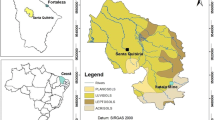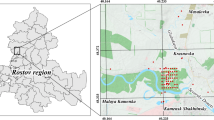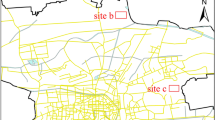Abstract
A study of agricultural lands around an abandoned Pb–Zn mine in a karst region was undertaken to (1) assess the distribution of heavy metals in the agricultural environment, in both dry land and paddy field; (2) discriminate between natural and anthropogenic contributions; and (3) identify possible sources of any pollution discovered. Ninety-two samples of cultivated soils were collected around the mine and analyzed for eight heavy metals, pH, fluoride (F−), cation exchange capacity, organic matter, and grain size. The eight heavy metals included Cd, Cr, Cu, Ni, Pb, Zn, As, and Hg. The average concentrations (mg/kg) obtained were as follows: Cd 16.76 ± 24.49, Cr 151.5 ± 18.24, Cu 54.28 ± 18.99, Ni 57.5 ± 14.43, Pb 2,576.2 ± 1,096, Zn 548.7 ± 4,112, As 29.1 ± 6.36, and Hg 1.586 ± 1.46. In a site where no impact from mining activities was detected, the mean and median of Cd, Cu, Ni, Pb, Zn, As, and Hg concentrations in investigated topsoils were higher than the mean and median of heavy metal concentrations in reference soils. An ensemble of basic and multivariate statistical analyses was performed to reduce the multidimensional space of variables and samples. Two main sets of heavy metals were revealed as indicators of natural and anthropogenic influences. The results of principal component analysis (PCA) and categorical PCA demonstrated that Cd, Cu, Pb, Zn, and Hg are indicators of anthropogenic pollution, whereas Cr, As and Ni concentrations are mainly associated with natural sources in the environment. The contamination from Pb–Zn mining operations, coupled with the special karst environment, was a key contributing factor to the spatial distribution of the eight heavy metals in the surrounding soil. The values of heavy metals in the soil samples suggested the necessity of conducting a rigorous assessment of the health and environmental risks posed by these residues and taking suitable remedial action as necessary.




Similar content being viewed by others
References
Abrahams PW (2002) Soils: their implications to human health. Sci Total Environ 291:1–32
Adriano DC (2001) Trace elements in the terrestrial environment. Biogeochemistry, bioavailability and risks of metals, 2nd edn. Springer, New York
Al-Khashman OA, Shavwabkeh RA (2006) Metal distribution in soils around the cement factory in southern Jordan. Eviron Pollut 140:387–394
Alvarez E, Fernandez-Marcos ML, Vaamonde CM, Fernandez-Sanjurjo J (2003) Heavy metals in the dump of an abandoned mine in Galicia (NW Spain) and in the spontaneously occurring vegetation. Sci Total Environ 313:185–197
Anderberg S, Stigliani WM (1994) Integrated approach for identifying sources of pollution: the example of cadmium pollution in the Rhine River Basin. Water Sci Technol 29:61–67
Bilos JCC, Colombo CN, Skorupka MJ, Rodriguez P (2001) Sources, distribution and variability of airborne trace metals in La Plata City area, Argentina. Environ Pollut 111:149–158
Bloemen ML, Markert B, Lieth H (1995) The distribution of Cd, Cu, Pb, and Zn in topsoils of Osnabruck in relation to land use. Sci Total Environ 166:137–148
Boluda R (1988) Relaciones estadísticas de los valores de Metales Pesados (Cd, Co., Cu, Cr, Ni, Pb y Zn) con el pH, contenido en materia orgánica, carbonatos totales y arcilla de los suelos de la comarca La Plana de Requena-Utiel (València). Anales de Edafología y Agrobiología 47:1503–1524
Brumelis G, Lapina L, Nikodemus O, Tabors G (2002) Use O of the horizon of forest soils in monitoring metal deposition in latvia. Water Air Soil Poll 135:291–309
Candeias C, Ferreira da Silva E, Salgueiro AR, Pereira HG, Reis AP, Patinha C, Matos JX, Avila PH (2011) The use of multivariate statistical analysis of geochemical data for assessing the spatial distribution of soil contamination by potentially toxic elements in the Aljustrel mining area (Iberian Pyrite Belt, Portugal). Environ Earth Sci 62:1461–1479
Carlon C, Critto A, Marcomini A, Nathanail P (2001) Risk based characterisation of contaminated industrial site using multivariate and geostatistical tools. Environ Pollut 111:417–427
Clemente R, Almela C, Bernal MP (2006) Are mediation strategy based on active phytoremediation followed by natural attenuation in a soil contaminated by pyrite waste. Environ Pollut 143:397–406
Colgan A, Hankard PK, Spurgeon DJ, Svendsen C, Wadsworth RA, Weeks JM (2003) Closing the loop: a spatial analysis to link observed environmental damage to predicted heavy metal emissions. Environ Toxicol Chem 22:970–976
Davies BE (1997) Heavy metal contaminated soils in an old industrial area of Wales, Great Britain: source identification through statistical data interpretation. Water Air Soil Poll 94:85–98
De Temmerman L, Vanongeval L, Boon W, Hoenig M (2003) Heavy metal content of arable soil in Northern Belgium. Water Air Soil Poll 148:61–76
Dragovic S, Mihailovic N, Gajic B (2008) Heavy metals in soils: distribution, relationship with soil characteristics and radionuclides and multivariate assessment of contamination sources. Chemosphere 72:491–495
Errecalde MF, Boluda R, Lagarda MJ, Farre R (1991) Indices de contaminación por metales pesados en suelos de cultivo intensivo: aplicación a la comarca de L’Horta. Suelo y planta 1:483–494
Ersoy A, Yunsel TY, Cetin M (2004) Characterization of land contaminated by heavy metal mining using geostatistical methods. Arch Environ Contam Toxicol 46:162–175
Facchinelli A, Sacchi E, Mallen L (2001) Multivariate statistical and GIS-based approach to identify heavy metal sources in soil. Environ Pollut 114:313–324
Gao Y, Wang YF, Zhang GM et al (2012) An approach for assessing soil health: a practical guide for optimal ecological management. Environ Earth Sci 65:153–159
Hanesch M, Scholger R, Dekkers MJ (2001) The application of Fuzzy C-Means cluster analysis and non-linear map** to a soil data set for detection of polluted sites. Phys Chem Earth Sci 26:885–891
He ZL, Yanga XE, Stoffellab PJ (2005) Trace elements in agroeco-systems and impacts on the environment. J Trace Elem Med Biol 19:125–140
Janssen RPT, Peijnenburg WJGM, Posthuma L, Van Den Hoop MAGT (1997) Equilibrium partitioning of heavy metal in Dutch field soils. I. Relationship between metal partition coefficients and soil characteristics. Environ Toxicol Chem 16:2470–2478
Kamenov GD, Brenner M, Jaimie L, Tucker JL (2009) Anthropogenic versus natural control on trace element and Sr–Nd–Pb isotope stratigraphy in peat sediments of southeast Florida (USA), ~1500 AD to present. Geochim Cosmochim Ac 73:3549–3567
Kashem MA, Singh BR (2001) Metal availability in contaminated soils: effects of flooding and organic matter on changes in Eh, pH and solubility of Cd, Ni and Zn. Nutr Cycl Agroecos 61:247–255
Kim KK, Kim KW, Kim JY, Kim IS, Cheong YW, Min JS (2001) Characteristics of tailings from the closed metal ines as potential contamination source in South Korea. Environ Geol 41:358–364
Kober B, Wessels M, Bollhofer A, Mangini A (1999) Pb isotopes in sediments of Lake Constance, Central Europe constrain the heavy metal pathways and the pollution history of the catchment, the lake and regional atmosphere—constrains on the origin(s) and flux(es) of metals. Geochim et Cosmochim Ac 63:1293–1303
Kools SAE, Boivin MY, Van Der Wurffd AWG, Van Gestela MPB, Van Straalen CAMNM (2009) Assessment of structure and function in metal polluted grasslands using terrestrial model ecosystems. Ecotoxicol Environ Safe 72(1):51–59
Krachler M, Zheng J, Koerner R, Zdanovich C, Fisher D, Shotyk W (2005) Increasing atmospheric antimony contamination in the northern hemisphere: snow and ice evidence from Devon Island, Arctic Canada. J Environ Monit 7:1169–1176
Li XH, Tang ZL, Chu FY et al (2011) Characteristics of distribution and chemical speciation of heavy metals in environmental mediums around **chang mining city, Northwest China. Environ Earth Sci 64:1667–1674
Lin YP (2002) Multivariate geostatistical methods to identify and map spatial variations of soil heavy metals. Environ Geol 42:1–10
Lorenzoni P, Spadoni M, De Simone C (1998) Distribution of heavy metal in calcareus soil of central Italy: a multivariate approach. Fresenius Environ Bull 7:678–684
Lu Y, Gong ZT, Zhang GL (2003) The chemical speciation of heavy metals of urban soils in Nan**g. Environ Chem 22(2):131–136 (in Chinese)
Luo W, Wang TY, Lu YL, Giesy JP, Shi YJ, Zheng YM, **ng Y, Wu GH (2007) Landscape ecology of the Guanting Reservoir, Bei**g, China: multivariate and geostatistical analyses of metals in soils. Environ Pollut 146:567–576
Mantovi P, Bonazzi G, Maestri E, Marmiroli N (2003) Accumulation of copper and zinc from liquid manure in agricultural soils and crop plants. Plant Soil 250:249–257
Martin HW, Kaplan DI (1998) Temporal changes in cadmium, thallium, and vanadium mobility in soil and phytoavailability under field conditions. Water Air Soil Poll 101:399–410
McKenzie ER, Money JE, Green PG, Young TM (2009) Metals associated with stormwater-relevant brake and tire samples. Sci Total Environ 407:5855–5860
Ministry of Environmental Protection of the People’s Republic of China (MEPC 2006) Technical Rule for Soil Sample Measuring in the Chinese Investigation on Soil Contamination
Nan Z, Zhao C, Jijun L, Chen F, Sun W (2002) Relation between soil properties and selected heavy metal concentration in spring wheat (Triticum aestivum L.) grown in contaminated soil. Water Air Soil Poll 133:205–213
National Environmental Protection Agency (NEPA) (1990) The background values of soil elements of China. Chinese Environmental Science Press, Bei**g (in Chinese)
National Environmental Protection Agency (NEPA) (1995) Environmental Quality Standards for Soils (in Chinese)
Nicholson FA, Smith SR, Alloway BJ, Carlton-Simith C, Chambers BJ (2003) An inventory of heavy metal input to agricultural soil in England and Wales. Sci Total Environ 311:205–219
Robertson GP, Klingensmith KM, Klug MJ, Paul EA, Crum JC, Ellis BG (1997) Soil resources, microbial activity, and primary production across an agricultural ecosystem. Ecol Appl 7:158–170
Rodriguez L, Ruiz E, Alonso-Azcarate J, Rincon J (2008) Heavy metal distribution and chemical speciation in tailings and soils around a Pb–Zn mine in Spain. J Environ Manage 90:1106–1116
Romic M, Romic D (2003) Heavy metal distribution in agricultural topsoils in urban area. Environ Geol 43:795–805
Schauer JJ, Rogge WF, Hildemann LM, Mazurek MA, Bend RC, Simoneit RT (1996) Source apportionment of airborn particulate matter using organic compounds as tracers. Atmos Environ 30:3837–3855
Shotyk W, Krachler M, Martinez-Cortizas A, Cheburkin AK, Emons H (2002) A peat bog record of natural, preanthropogenic enrichments of trace elements in atmospheric aerosols since 12,370 14 C yr BP, and their variations with Holocene climate change. Earth Planet Sci Lett 199:21–37
Sinha S, Banerjee SP (1997) Characterization of Haul road dust in an Indian open cast iron ore mine. Atmos Environ 31:2809–2814
United States Environmental Protection Agency (USEPA 1996) Soil Screening Guidance: User’s Guide (revision 2)
Van Den Hout KD, Bakker DJ, Berdowski JJ, Van Jaarsveld JA, Reinds GJ, Bril J, Breeuwsma A, Groenenber JE, De Vries W, Van Pagee JA, Villars M, Sliggers CJ (1999) The impact of atmospheric deposition of nonacidifying substances on the quality of European forest soil and north sea. Water Air Soil Poll 109:357–396
Vega FA, Covelo EF, Andrade ML (2006) Competitive sorption and desorption of heavy metals in mine soils: influence of mine soil characteristics. J Colloid Interf Sci 298:582–592
Wang YP, Bao ZY, Hou SE (2000) Study on characteristics of heavy metal specie in the soils near the tailings. Rock Mineral Anal 19(1):7–13 (in Chinese)
Wei FS, Chen JS, Wu YY, Zheng CJ (1992) The study of environmental background values of soil in China. Environ Sci 12:12–19 (in Chinese)
Acknowledgments
This work was supported by the National Basic Research Program of China (2004CB418507), the National Natural Science Fund of China (40861024), and the Guangxi Scientific and Technological Brainstorm Project, Science and Technology (Guikegong 0779011). The assistance in sample analysis from the Guangxi Test Center of Geology and Mine is also greatly appreciated. The authors would like to thank the reviewers for their valuable comments which highly improved the manuscript. Appreciation should be directed to Dr. Donald G. Barnes, a visiting professor of Guangxi University and an anonymous reviewer who offered valuable comments and detailed revisions for the manuscript.
Author information
Authors and Affiliations
Corresponding author
Rights and permissions
About this article
Cite this article
Huang, LM., Deng, CB., Huang, N. et al. Multivariate statistical approach to identify heavy metal sources in agricultural soil around an abandoned Pb–Zn mine in Guangxi Zhuang Autonomous Region, China. Environ Earth Sci 68, 1331–1348 (2013). https://doi.org/10.1007/s12665-012-1831-8
Received:
Accepted:
Published:
Issue Date:
DOI: https://doi.org/10.1007/s12665-012-1831-8




